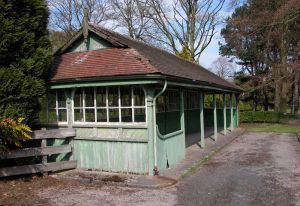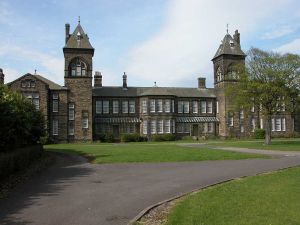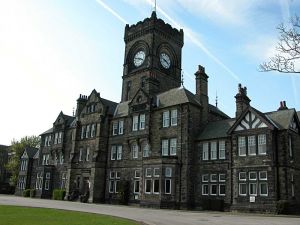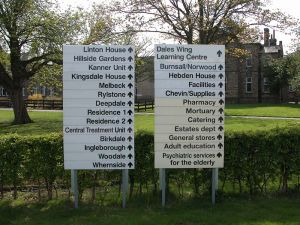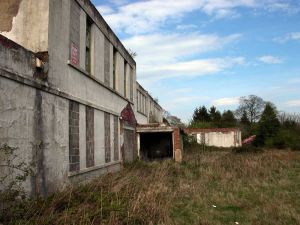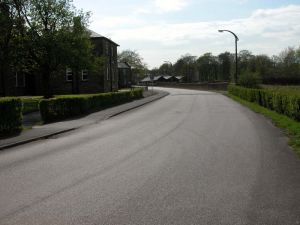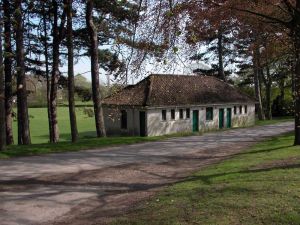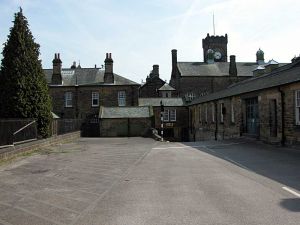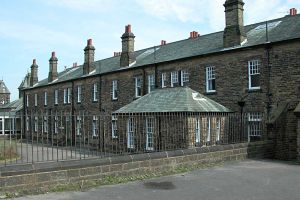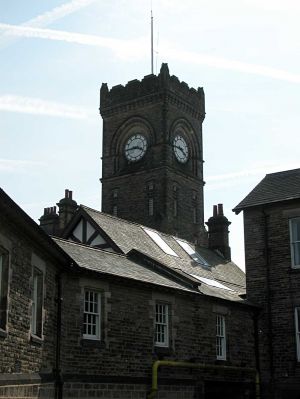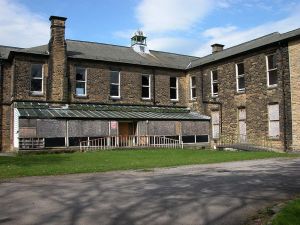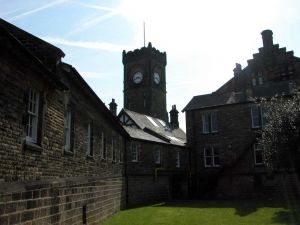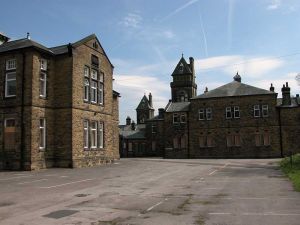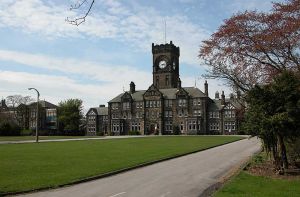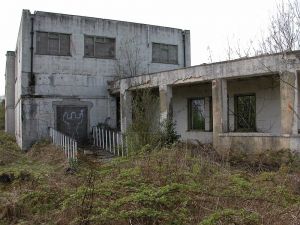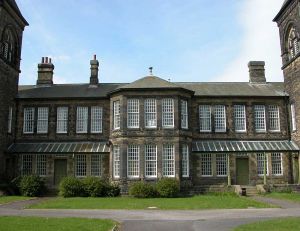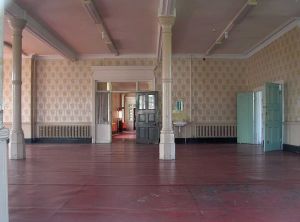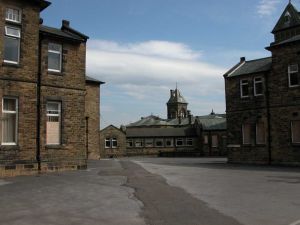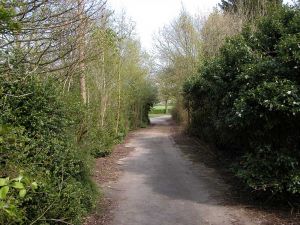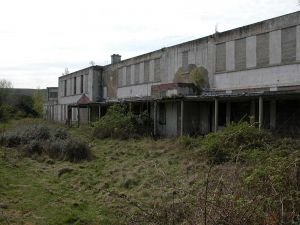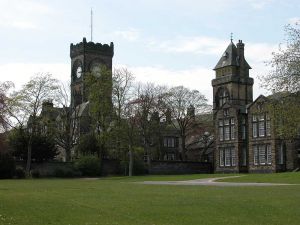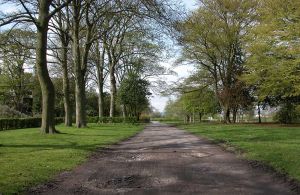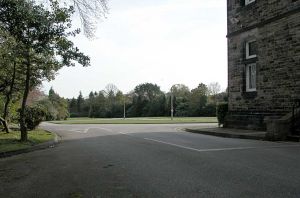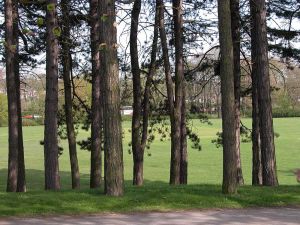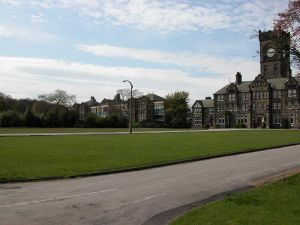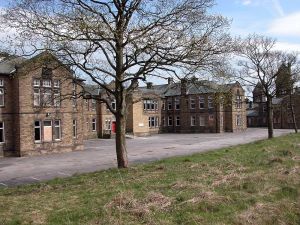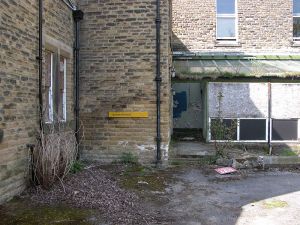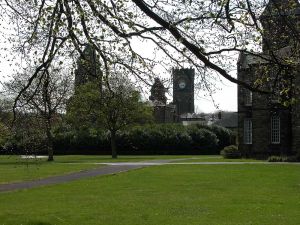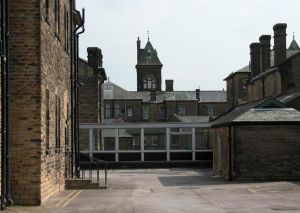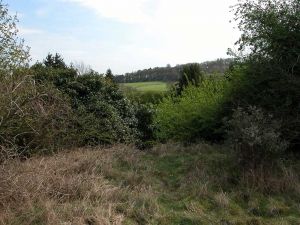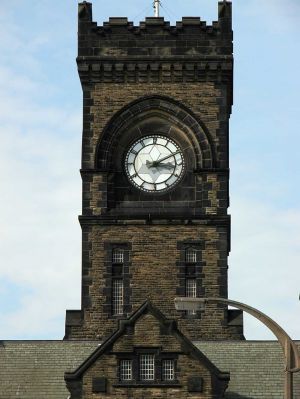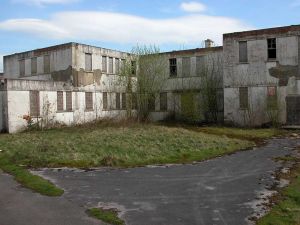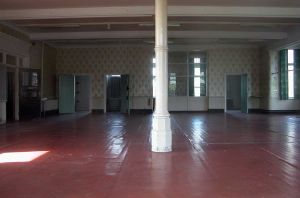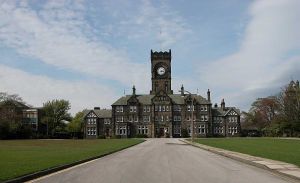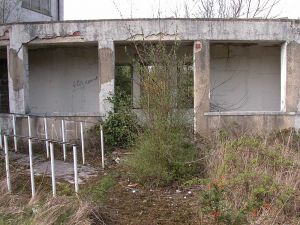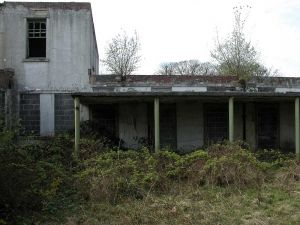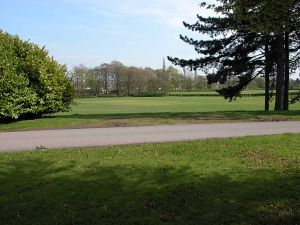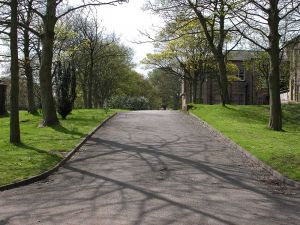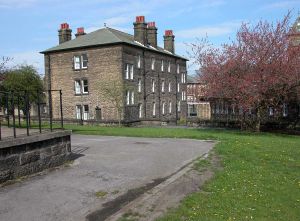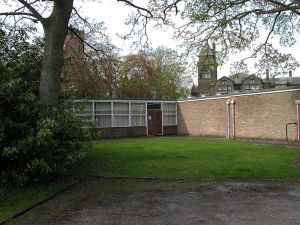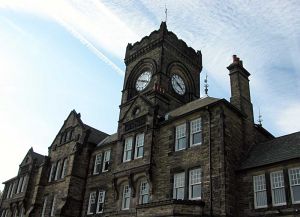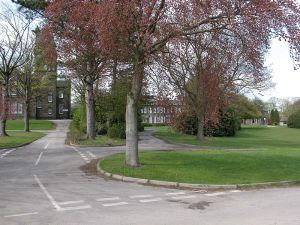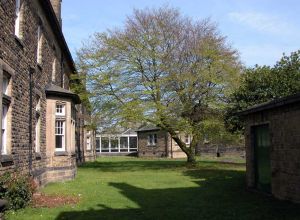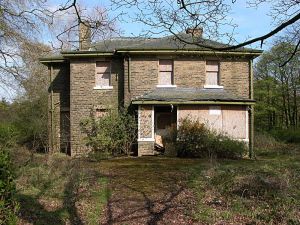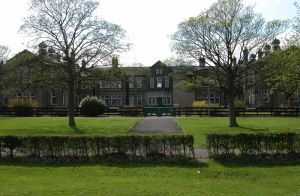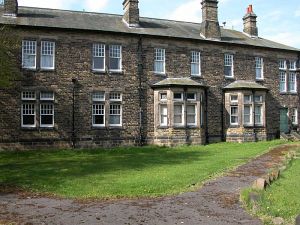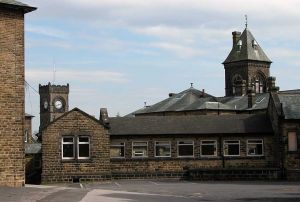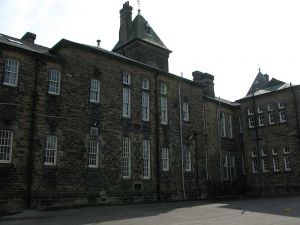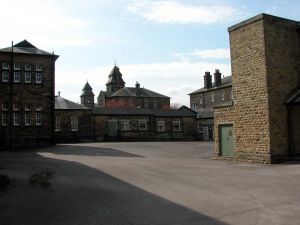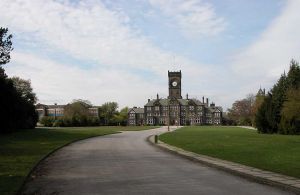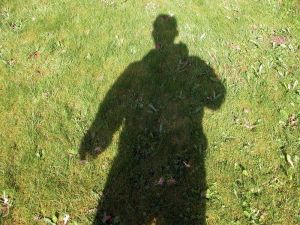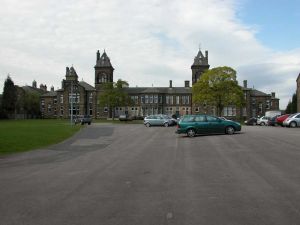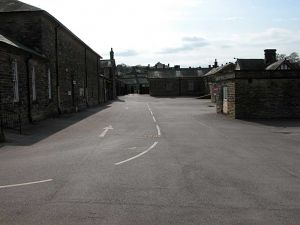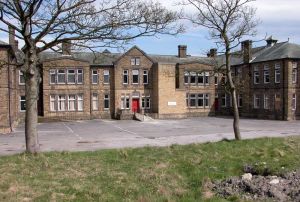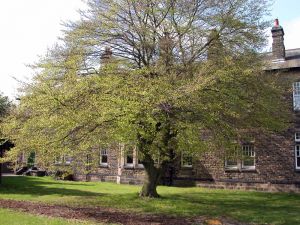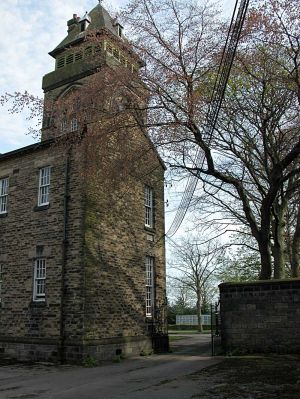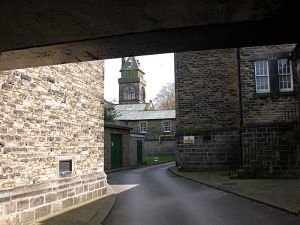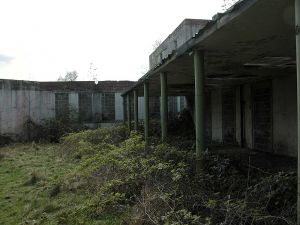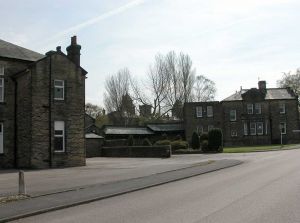Many thanks to Patrick Goulden for sending this wonderful account of his time nursing at High Royds.
“No-one ever forgets their first sight of High Royds Hospital. Mine was in November 1986, coming for a job interview. I was 19 years old, and I’d heard that High Royds were having an intake of student nurses, so made an application and got an interview. I had caught the 734 bus from Kirkstall, and passed through Guiseley for the first time – no McDonalds, no Morrisons, no KFC, all this would arrive in the next few years.
It was bitterly cold, and a freezing rain gave me a thorough soaking within minutes. I actually thought of forgetting the interview and turning around, because I didn’t want my prospective employers to burst out laughing at a diminutive, waterlogged idiot trying to explain why he thought he could help people with mental health problems, whilst shivering and sneezing uncontrollably. But, I decided against it, and pressed on up the endless main drive. I didn’t know much about the place, other than it had opened at the end of the nineteenth century, around the time that Jack the Ripper was showing his unnatural fixations with a certain cross-section of the population.
I had walked up most of the curved drive with my head down, in a pointless effort to dodge some of the rain. (The curvature of the drive, by the way, was so the patients couldn’t see any sign of outside life, and nothing too revealing about the hospital was obvious to the outside world – the Victorians were of the opinion that Mental Illness should be carefully hidden from society, and was a thing of great shame. The curve in the drive was actually where the term ‘sent round the bend’ originated.) I took a quick look upwards to get my bearings, and what I saw literally stopped me in my tracks. A huge, imposing, gargantuan building, brooding and menacing beyond belief in its appearance. It looked like something from a horror film, a sort of sleeping Kraken. The huge storm clouds above did nothing to alleviate any sudden anxiety. What was I getting myself into?
I can remember sitting in the old school of nursing, talking to a few people who had started their training in what would be the previous intake to my own. They were nice guys, completely barmy, and actually found a towel to help me dry off at least a little. Then came my actual interview, with Mr. Ostick and Mr. Morris. (if you read this, Jack, it’s been twenty-one years now….) Some years later, I would read my interview notes, the bottom of which said “the interview turned into a friendly chat.” I passed, and started on Monday January 19th, 1987, two days after my twentieth birthday.
I had moved into Room Two, Residence One the night before, had lain awake for most of the night listening to not so much a lively party but a badly controlled riot, then to have about an hour’s worth of sleep disturbed by what appeared to be a town crier outside my window at around five in the morning. I would later learn that this was Jan Klempka, a Polish man who had ‘lived’ at High Royds since the second world war. He was an incredibly sweet-natured individual, considering his lot in life. He would be a regular visitor to most of the wards in the hospital – I’d make him a pot of tea when he came onto where I worked.
There was about thirteen of us in our training group – one girl dropped out fairly quickly because, to put it simply, it just wasn’t for her. She thought she was too ‘hard’, which I thought was a terrible shame because she was a thoroughly genuine person, a real ‘what you see is what you get’ character. There aren’t enough of those in the profession, and there never has been. We did a more traditional form of training, the last syllabus prior to Project 2000, where you did a few weeks in school for each ‘block’ – rehabilitation, acute psychiatry, care of the elderly, etc. – then you were on the wards for weeks at a time, with an occasional study day.
In other words – here it is, now get on with it. I can vividly remember my first shift on Denton Ward, starting at six o’clock in the morning on a Sunday. Of course, I’d had a few medicinal beverages the night before. Just so I’d sleep well, mind you. This, as it turned out, was not recommended, and I remember a few scathing remarks about perhaps getting a few more hours sleep before my next shift, and going steady on Grandpa’s cough mixture next time. At this point, I was introduced to a member of High Royds folklore and legend, the very lovely Mr. Arthur Robinson, Charge Nurse. “Get the kettle on, lad, and you’ve cracked it. Ah Can’t stand these new fangled bleedin’ perfumes, they knock me aaaht of a morning.”
I made a very shaky start on Denton Ward and have to say that at first, I hated it. I actually came very close to packing it in within about two months, because there were some volatile characters on there who didn’t mince their words, and thought that a towering, furious, volcanic rage was a valuable learning experience for some junior staff. One of the things I have learnt again and again over the last twenty-one years is that dealing with staff, and managing them as I do now is ALWAYS the hardest part of the job, no doubt about it. I’ve met some very caring, dedicated and just plain decent human beings in my time, and I’ve also met some glaring psychopaths who are frankly in the job for all the wrong reasons – quite a few of them have attained senior positions, in fact. I think it’s quite common in any industry or large organisation. Another thing I’ve learnt over a long time, is that it is never a case of ‘Us & Them’ when it comes to being a nurse – some of the people I’ve met, supposedly in positions of responsibility, had far worse social and mental health problems than the individuals they were charged with delivering care to. Talking about ‘Us and Them’ again, it’s a simple case of “There by the Grace of God Go I.” One in five people will have a mental health problem at some point, so badly that they will need treatment for it. The actual theory behind illness as a process is very important to learn, and as a qualified nurse you have your code of conduct to underpin what you do, but you never forget that you’re dealing with a human being, and that on that basis you should make yourself approachable and friendly. I’ve seen so many people get this badly wrong, and apparently see it as their role to trot out these stylised, soulless nursing interventions, rather like a superannuated mechanical dictionary. Obviously you need to know your stuff – but don’t forget basic things – a sense of humour, when it’s appropriate, can diffuse a very tense situation in a matter of seconds.
I finished Denton Ward on a good note – there was a minor comment about my timekeeping which was fair enough. In my defence, your honour, I was twenty years old and rather too interested in the completely wild and uncontrollable parties that took place virtually every night in the nurses residences. Not just a few beers then bed – just absolute, total mayhem until about 5 or6 a.m. and more often than not, destruction to property and a very stern ticking off from the Residence Co-Ordinator the morning after. I could always do a really good ‘who, me?’ face though. If you’re reading this, Margaret – I can’t apologise enough. Yes, it was ME that helped to put a sheep in a bedroom in Residence Two. I was also one of the six man team that picked up a certain staff nurses’ Reliant Robin, and put it in the lounge in Residence Two. Guilty as charged. By this time, about six months in, I’ve got used to my new surroundings, and must say that I rather like them. I’ve always been very fond of old buildings for reasons that I can’t quite put my finger on – Battersea Power Station for instance, designed by Sir Giles Gilbert Scott (the same geezer that invented red telephone boxes!) has always been very hypnotic to me, a thing of great beauty. I really don’t know why, perhaps it’s just fascination that human beings can create something so incredibly large and beautiful to look at. High Royds was typical of the Victorian mentality, which was roughly “If you’re going to do something, don’t muck about. Do it properly, or not at all.” It was built with a level of craftsmanship and attention to detail that you simply won’t see again – just look at the stone work on the administration building, for instance. Look at the new buildings on the site – and compare them to the old ones. Enough said.
I suppose like everyone else, I had my ‘favourite’ kinds of nursing. I loved acute psychiatry, and my last allocation as a student Nurse was on Denton Ward again – much busier than it ever was, by now having a mother and baby unit and six addiction unit beds. I’d done my share of everything else – care of the elderly, rehabilitation, community. I liked rehab, too – I remember having to quell quite an incident in a restaurant in Leeds, having taken one of my ‘charges’ there, for a spot of lunch. He became most irked and created a tumultuous fracas, shouting at the top of his voice that he would be shot if he didn’t eat all his peas. The restaurant owners, clearly not happy, invited us to depart at haste, and that we were not required to pay.
I used to get quite irked listening to people who had mapped out their every career move for the next fifty years – I never did this, because to me, having a rigid plan meant that you were kind of stuck if something new and interesting came up. The sort of people who did that, in my experience, were far too self serving to be of any actual use to the people they were charged with looking after. That’s not to say that you shouldn’t plan things a bit, or stick in the same job for years on end. Myself, I see nursing as a vocation, and I hope I always do. I still have all the patience in the world for someone who has suddenly developed a serious mental illness. Watching them come out of it, when you’ve helped ‘shore up the dam’ so to speak – there’s nothing like it.
Now, I don’t mean to sound like a half-baked clairvoyant of some kind, but a building with so much illness, misery and desperation imprinted on it over many years, talks to you in a manner of speaking. Within a few weeks of taking up my new home and place of work, I started having some VERY detailed and vivid dreams – usually about wards underneath the hospital, staff in Victorian / Edwardian nursing uniforms, horrific ‘treatments’ being administered. It transpired that there were some underground areas in parts of the hospital (I eventually saw some of these) where people were kept, apparently if they were particularly noisy or disruptive. The subterranean corridors at the lower end of the hospital are all sealed off now, but I can’t say I’d like to be near them – a house in the old Conistone Ward? No thanks! The year the hospital was closed, I went to Corfu on holiday, and every night, dreamed about the hospital despite being about two thousand miles away from it. The dreams were usually about long since forgotten parts of the hospital being unearthed, and what was inside them – people slowly and aimlessly shuffling about, with horrible, demonic, twisted faces.
I think the rational explanation for this is because I was missing the place, but a more imaginative person might say that it was trying to tell me that its closure should not have happened, because of the large amounts of ‘occupants’ that still live there. Twenty one years as a psychiatric nurse has taught me that there is no God – or, if there is, it is an incredibly neglectful one that allows so much suffering and illness – but it’s had me wondering on several occasions about what awaits us once we are gone.
One fairly quiet night in Nurses’ residence (and I’m now in Room 5, the old Matron’s room in residence one) the doorbell goes. It’s about three o’clock in the morning, so I’m wondering who exactly it is…. On opening the door, there is an old and frail looking woman in a black night-gown, with an embroidered pattern on the front of it. She smiled very politely, and didn’t answer when I asked who she was. Thinking she had taken a brief wander from one of the wards, I asked her to come inside. I made a few phone calls to the wards, asking if they had anyone missing, giving a description of my new ‘guest’. No, there was no-one missing. The last phone call I received was a bit less perfunctory. “Can you describe her again?” – duly done. There was a few moments’ silence, then my caller said (I remember this in substance, if not in detail) “I’m fairly sure she won’t be there when you go back downstairs. I’ll come over.” Sure enough, there was no sign of the lady that had paid a visit. I’d have heard the residence door close – it was about the size of a barn door; she was about the size of a mouse. A quick ‘circle’ up towards the main corridor, back round to the bottom door of nurses’ residence, not into the car park because the door had been locked. Up to the post room corridor and back. There was no sign of her, and nowhere she could have gone. I’m suddenly FREEZING cold, and its early summer. My last caller then arrived, rather wild-eyed, telling me she was sure that I had just met one of the previous occupants of the Nurses Residence, from some seventy or eighty years ago. I’m quite sure there is a rational explanation for all this, but it hasn’t occurred to me quite yet.
I spent about ten years living at High Royds, which was probably a mistake. I had some of the worst times of my life there, and some of the very best. Leaving it was an awful wrench, like abandoning the family home – that’s what it felt like for a lot of people who worked there. For quite unfortunate reasons, it was the place that had felt most like home – my family and upbringing were very difficult, and it was a period of stability for me. I think it’s fair to say I was brought up by psychiatric nurses. I qualified in 1990, eventually leaving in 1997. Like it or not, the place is permanently imprinted on me, and I suppose I see it as a spiritual home – I knew from quite an early age, listening to ‘Brain Damage’ by Pink Floyd (and other reasons!) that I wanted to be a psychiatric nurse, and here was the place it all happened for me. Such a beautiful place, all those acres of open space and woodlands. I met a huge variety of individuals, and mentioned before that nursing seems to attract some people who are probably best staying away from those with mental health problems – but I also met some truly sublime, salt-of-the-earth characters – for whom nothing was ever too much trouble. You all know who you are. The rest of you – stay gone.
And what of it now? I’m saddened every time I drive past the place – not for my own sense of loss, but because such a beautiful and historic place has been sold off on the cheap, and is now in the hands of development and marketing men, slowly and steadily mangling it, knocking down the bits they don’t like or that won’t sell. The last time I saw the Admin building, the first part of the hospital I ever saw, there was a gigantic hole in its roof and I’ve seen pictures of the widespread flooding inside it. If it REALLY had to shut (and I don’t think it did!) then at least do something respectful to the people who died there – maybe turn it into a museum. Just don’t consign it to the shark infested waters of property development, then stand back and watch it fall to bits. In a few more years, it won’t be worth salvaging.
I’m very proud of the fact that I worked at High Royds. I miss it like hell, but I’ll be saying that about where I work now in a short time. You have to enjoy what you have while you have it, because it’ll be gone much sooner than you think. I want to thank you for a brilliant site, Mark, keep up the excellent work – nice to see the ‘family home’ is in such careful hands.”
